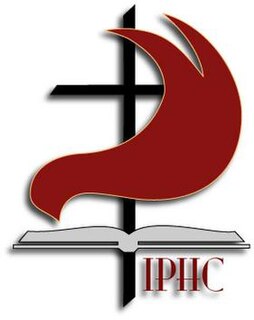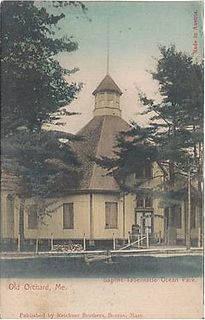
The Holiness movement involves a set of Christian beliefs and practices that emerged chiefly within 19th-century Methodism, and to a lesser extent other traditions such as Quakerism and Anabaptism. The movement is Wesleyan-Arminian in theology, and is defined by its emphasis on the doctrine of a second work of grace leading to Christian perfection. A number of evangelical Christian denominations, parachurch organizations, and movements emphasize those beliefs as central doctrine. As of 2015, Holiness movement churches had an estimated 12 million adherents.
The Pentecostal Free Will Baptist Church (PFWBC) is a church group in the southern United States, best thought of as Pentecostal rather than Baptist. The PFWBC is historically and theologically a combination of both, having begun as a small group of churches in North Carolina that broke away from the Free Will Baptist Church to join the Holiness movement and eventually accepting certain Pentecostal doctrines.

The Holiness Baptist Association is a holiness body of Christians with Baptist historical roots.

The International Pentecostal Holiness Church (IPHC) or simply Pentecostal Holiness Church (PHC) is a Pentecostal Christian denomination founded in 1911 with the merger of two older denominations. Historically centered in the Southeastern United States, particularly the Carolinas and Georgia, the Pentecostal Holiness Church now has an international presence. In 2000, the church reported a worldwide membership of over one million—over three million including affiliates.

The Fire Baptized Holiness Church of God of the Americas is a predominantly African-American Holiness-Pentecostal Christian denomination based in the United States. Originating when the African American members of the integrated Fire-Baptized Holiness Church withdrew to form their own organization, the church was founded at Greer, South Carolina in 1908.
The United Holy Church of America, Inc. is the oldest African-American Holiness-Pentecostal body in the world. It was established in 1886. It is a predominantly black Pentecostal Holiness Christian denomination, and the International Headquarters is located in Greensboro, North Carolina. The UHCA consists of 516 churches, 17 districts, and 8 territories. The largest and the oldest district of the connectional body is the Southern District Convocation.

The camp meeting is a form of Protestant Christian religious service originating in England and Scotland as an evangelical event in association with the communion season. It was held for worship, preaching and communion on the American frontier during the Second Great Awakening of the early 19th century. Revivals and camp meetings continued to be held by various denominations, and in some areas of the mid-Atlantic, led to the development of seasonal cottages for meetings.

The Wesleyan Methodist Church of Australia is a Christian denomination with its origins in Wesleyan Methodism. It is the organisational name for contemporary The Wesleyan Church in Australia.

Massey Hill Classical High School (MHCHS) is a high school in Fayetteville, Cumberland County, North Carolina. The main building of the Massey Hill Classical High School was built in 1925. It is a two-story brick building on a raised basement in the Classical Revival-style. What is now known as the Science Building was added in 1942 and eventually expanded to twelve classrooms. The gymnasium was built in 1947. The gymnasium has served as a community recreation center and is still used by the Recreation Department for evening basketball.
The Fire-Baptized Holiness Church was a radical holiness Christian denomination in North America and was involved in the early formation of Pentecostalism. Founded in 1895, it merged with the Pentecostal Holiness Church in 1911, forming a new denomination now known as the International Pentecostal Holiness Church. Prior to the merger the Fire-Baptized Holiness Church was an interracial body. In 1908, most of the African-American members withdrew to form their own church, the Fire Baptized Holiness Church of God of the Americas.

The Temple is a historic octagon-shaped Baptist church building on Temple Avenue in the Ocean Park area of Old Orchard Beach, Maine. Built in 1881, it is the centerpiece of the summer camp meeting established in 1880 by Free Will Baptists led by Bates College President Oren Cheney. It is the only known octagonal religious structure currently in use in the state. It was listed on the National Register of Historic Places in 1975, and included in the Ocean Park Historic Buildings district in 1982.

McBee Methodist Church, also known as McBee Chapel, is an octagonal, brick, United Methodist church building on Main Street in Conestee, Greenville County, South Carolina. Built in 1856, it was designed by millwright John Adams and named for Vardry McBee (1775–1864), the "Father of Greenville," whose son donated the money to build it. The church was built with a balcony used by slaves. When the balcony was removed sometime following the Civil War, its separate door, to the left of the main entrance, was converted into another window.
The People's Methodist Church was a Wesleyan-Holiness denomination in the Southern United States from 1938–1962 founded by revivalist Jim H. Green.

Indian Field Methodist Campground is a camp meeting site for the Methodist Church in Dorchester County, South Carolina. It is on SC Route S-18-73, off US Route 15, about 5 mi (8 km) north of Saint George. Indian Field was built in 1848 and has been a site for religious gatherings for over 160 years. It is associated with the Indian Field United Methodist Church located on U.S. Highway 15 about 2 miles north of the campground and just south of U.S. Highway 178. It was named a historic district of the National Register of Historic Places on March 30, 1973.

East Avenue Tabernacle Associate Reformed Presbyterian Church, also known as the Great Aunt Stella Center, is a historic Associate Reformed Presbyterian church located at 927 Elizabeth Street in Charlotte, Mecklenburg County, North Carolina. It was designed by architect James M. McMichael in a Classical Revival style. It consists of a two-story sanctuary, built in 1914, and a four-story educational wing added to the south side of the sanctuary in 1925. The sanctuary has a Greek cross plan with a central octagon with shallow two-story wings that terminate in low parapeted walls. The sanctuary is topped by a copper dome and has a monumental porch with a brick pediment. In 1998 East Avenue Tabernacle merged with the Craig Avenue Associate Reformed Presbyterian Church. Ultimately the church became the Craig Avenue Tabernacle A.R.P. Church. Thus ironically through the years the name changed from East to Craig Avenue. The building now houses a community center and charter school.

Piedmont Camp Meeting Grounds Historic District is a national historic district located at Piedmont, Montgomery County, Virginia. The district encompasses 22 contributing buildings associated with a seasonal religious campground. The district includes a large, rustic tabernacle (1939), a group of small frame cabins, a dining hall in a former church building, the concrete block Piedmont Pentecostal Holiness Church, and the nave-plan Piedmont Methodist Church, the district's oldest building. The tabernacle is the principal structure in the campground, and is an aisled gable roofed frame structure open on three sides and supported by untrimmed logs. The Piedmont Methodist Church is the church from which the Piedmont Pentecostal Holiness group broke away.

Southwest Virginia Holiness Association Camp Meeting, also known as the Salem Camp Meeting, is a historic camp meeting complex located at Salem, Virginia. The complex consists of two buildings—a 1922 tabernacle and a dormitory, built about 1926. Both buildings are plainly detailed frame buildings with novelty weatherboard siding and poured concrete basement levels. The tabernacle measures approximately 60 feet by 80 feet and contains an auditorium designed for a capacity of 2,000 people. The dormitory is a two-story, three bay, building with a full-width one-story porch.

The Reformed Free Methodist Church (RFMC) was a Methodist denomination in the conservative holiness movement.


















